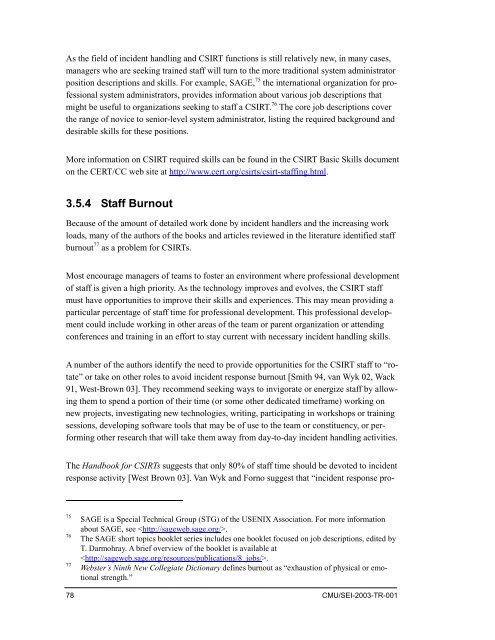State of the Practice of Computer Security Incident Response Teams ...
State of the Practice of Computer Security Incident Response Teams ...
State of the Practice of Computer Security Incident Response Teams ...
Create successful ePaper yourself
Turn your PDF publications into a flip-book with our unique Google optimized e-Paper software.
As <strong>the</strong> field <strong>of</strong> incident handling and CSIRT functions is still relatively new, in many cases,<br />
managers who are seeking trained staff will turn to <strong>the</strong> more traditional system administrator<br />
position descriptions and skills. For example, SAGE, 75 <strong>the</strong> international organization for pr<strong>of</strong>essional<br />
system administrators, provides information about various job descriptions that<br />
might be useful to organizations seeking to staff a CSIRT. 76 The core job descriptions cover<br />
<strong>the</strong> range <strong>of</strong> novice to senior-level system administrator, listing <strong>the</strong> required background and<br />
desirable skills for <strong>the</strong>se positions.<br />
More information on CSIRT required skills can be found in <strong>the</strong> CSIRT Basic Skills document<br />
on <strong>the</strong> CERT/CC web site at http://www.cert.org/csirts/csirt-staffing.html.<br />
3.5.4 Staff Burnout<br />
Because <strong>of</strong> <strong>the</strong> amount <strong>of</strong> detailed work done by incident handlers and <strong>the</strong> increasing work<br />
loads, many <strong>of</strong> <strong>the</strong> authors <strong>of</strong> <strong>the</strong> books and articles reviewed in <strong>the</strong> literature identified staff<br />
burnout 77 as a problem for CSIRTs.<br />
Most encourage managers <strong>of</strong> teams to foster an environment where pr<strong>of</strong>essional development<br />
<strong>of</strong> staff is given a high priority. As <strong>the</strong> technology improves and evolves, <strong>the</strong> CSIRT staff<br />
must have opportunities to improve <strong>the</strong>ir skills and experiences. This may mean providing a<br />
particular percentage <strong>of</strong> staff time for pr<strong>of</strong>essional development. This pr<strong>of</strong>essional development<br />
could include working in o<strong>the</strong>r areas <strong>of</strong> <strong>the</strong> team or parent organization or attending<br />
conferences and training in an effort to stay current with necessary incident handling skills.<br />
A number <strong>of</strong> <strong>the</strong> authors identify <strong>the</strong> need to provide opportunities for <strong>the</strong> CSIRT staff to “rotate”<br />
or take on o<strong>the</strong>r roles to avoid incident response burnout [Smith 94, van Wyk 02, Wack<br />
91, West-Brown 03]. They recommend seeking ways to invigorate or energize staff by allowing<br />
<strong>the</strong>m to spend a portion <strong>of</strong> <strong>the</strong>ir time (or some o<strong>the</strong>r dedicated timeframe) working on<br />
new projects, investigating new technologies, writing, participating in workshops or training<br />
sessions, developing s<strong>of</strong>tware tools that may be <strong>of</strong> use to <strong>the</strong> team or constituency, or performing<br />
o<strong>the</strong>r research that will take <strong>the</strong>m away from day-to-day incident handling activities.<br />
The Handbook for CSIRTs suggests that only 80% <strong>of</strong> staff time should be devoted to incident<br />
response activity [West Brown 03]. Van Wyk and Forno suggest that “incident response pro-<br />
75<br />
76<br />
77<br />
SAGE is a Special Technical Group (STG) <strong>of</strong> <strong>the</strong> USENIX Association. For more information<br />
about SAGE, see .<br />
The SAGE short topics booklet series includes one booklet focused on job descriptions, edited by<br />
T. Darmohray. A brief overview <strong>of</strong> <strong>the</strong> booklet is available at<br />
.<br />
Webster’s Ninth New Collegiate Dictionary defines burnout as “exhaustion <strong>of</strong> physical or emotional<br />
strength.”<br />
78 CMU/SEI-2003-TR-001
















